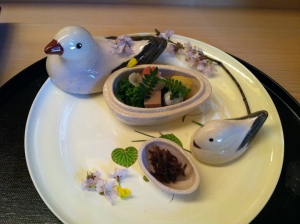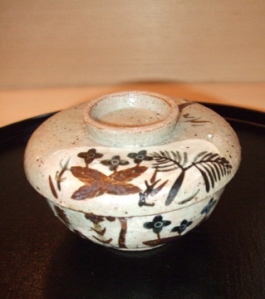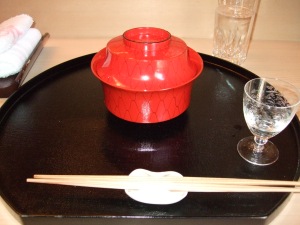I finally got to cross a restaurant off my bucket-list this year when I visited Kichisen in northern Kyoto, Japan. The experience was everything I’d hoped for and more. Kichisen specializes in traditional Kyo Kaiseki cuisine. The ingredients are chosen based on what is in season, fresh, and at its peak. The natural flavors of the ingredients shine through in the dishes, and the beautiful presentation of the courses incorporates aspects of nature during that season as well. This restaurant currently has three well-deserved Michelin Stars.
There are many courses, and one does not choose the individual dishes. That is up to the chef. Instead you choose a price point and will be presented with finer ingredients the higher up you go. Kyo-Kaiseki does not come cheap, and being that this was my first experience at this restaurant, I chose the lunch course that was 8,000 Yen per person. The exchange rate varies, but that’s roughly $80 a person USD. Keep in mind there is an addition of about 20% that will be made to your bill later for service fees and tax. This is a steal considering dinner starts at almost double the price, and you are getting service and food that would cost you at least twice this price in the U.S. for food of this quality. The lunch also took about three hours, and was a culinary experience not to be forgotten.
Having lived in Japan and visited many times, I am not new to kaiseki. I chose to visit Kichisen because of Chef Tanigawa. You may know him as the chef who defeated the Iron Chef Morimoto in the Iron Chef “Battle of the Pike Eel” episode. This guy can do some amazing things with food. I have quite enjoyed some Asian fusion cuisine at Morimoto’s restaurant in Philadelphia several times. I had to see what the guy that beat him was capable of.
When my husband, my friend, and I arrived at the entrance, we were greeted by a server who took our name from the list and lead us inside to the genkan (entry hallway where you remove your shoes) and took our coats. We were then lead into the area with the counter seats that my friend had reserved for us a month prior. If you don’t speak Japanese well and you don’t have a friend who does, you can have your hotel call to make the reservation for you.

Since it was April 1st and the beginning of the cherry blossom season in Kyoto, we were first given sakura (cherry blossom) water. The liquid was very fragrant, but the taste was very subtle and pleasant.
Traditional Kyo-Kaiseki is based on some elements of the tea ceremony. We were given tea ceremony sweets (wagashi) next. I liked the idea of starting with something a little bit sweet. Don’t worry, that doesn’t mean you don’t get dessert later. The inside was sweet azuki or red bean paste. My husband’s was particularly special because it was covered in matcha (green tea) powder. Both were presented in black lacquer boxes.
And what would wagashi be without matcha? Oh yeah, this was the good stuff. Nice and grassy and frothy. I was in heaven.

We ordered some amai or sweet sake to share between the three of us. Surprisingly it was only about 1,200 Yen for this bottle, and it was presented on a bed of ice with some cherry blossoms. This sake was so smooth that we proceeded to order two more during the course of our meal.
 Then the first savory dish came out. It was beautifully presented in little ceramic containers shaped like birds, with real cherry blossoms placed on the plate. The chef’s assistant was very friendly and saw that I wanted to take pictures. He would wait for me to take a picture when the dish was presented and then open the containers for me. It sounds simple, but it’s very nice because many upscale establishments like this, especially in Tokyo, won’t let you take photos of the food. I also didn’t feel rushed or uncomfortable for doing so.
Then the first savory dish came out. It was beautifully presented in little ceramic containers shaped like birds, with real cherry blossoms placed on the plate. The chef’s assistant was very friendly and saw that I wanted to take pictures. He would wait for me to take a picture when the dish was presented and then open the containers for me. It sounds simple, but it’s very nice because many upscale establishments like this, especially in Tokyo, won’t let you take photos of the food. I also didn’t feel rushed or uncomfortable for doing so.
Inside the large bird was a medley of fresh seasonal vegetables, while the small one was full of sweet and salty seaweed. I loved the presentation of this dish. It was also exciting anticipating what dishes lay inside.
 So far I hadn’t seen Chef Tanigawa. I really wasn’t surprised because I’ve been to Morimoto four times, and of course have never seen him. Still I was hoping I’d see Tanigawa since this is such a small restaurant.
So far I hadn’t seen Chef Tanigawa. I really wasn’t surprised because I’ve been to Morimoto four times, and of course have never seen him. Still I was hoping I’d see Tanigawa since this is such a small restaurant.
Then out of nowhere he appeared and brought us the next course! I was so excited and for the next two hours, he was around most of the time serving us, and spent a lot of time talking to us. My Japanese isn’t so great, so I can’t carry on a conversation for very long. Luckily, my friend speaks excellent Japanese due to living in Japan for around eight years, and he was able to ask Tanigawa the things I couldn’t.
Tanigawa brought us this beautiful dish of what he said were beans (usui endo) and not peas in a light syrup. This dish was possibly the freshest thing I’ve ever tasted. It was screaming spring and the texture of the beans were creamy and tender. The syrup was so light, but it brought out more of the natural sweetness in the bean. The beautiful cobalt blue and gold glassware it was served in was the perfect vessel for this simple well-executed course.
 The next course was also impressive due to the quality of the ingredients. It was another very light dish. This time a soup with a slightly sweet clear broth, fresh greens, tofu, and the most flavorful, tender mushroom I think I’ve ever eaten. I asked Chef Tanigawa if the shitake mushroom was marinated in something to give it that amazingly rich flavor. To my surprise, he said it wasn’t seasoned at all, but just put directly into the stock. The reason it tastes so amazing is that it is incredibly fresh. I think I could have eaten a giant bowl of full of those mushrooms.
The next course was also impressive due to the quality of the ingredients. It was another very light dish. This time a soup with a slightly sweet clear broth, fresh greens, tofu, and the most flavorful, tender mushroom I think I’ve ever eaten. I asked Chef Tanigawa if the shitake mushroom was marinated in something to give it that amazingly rich flavor. To my surprise, he said it wasn’t seasoned at all, but just put directly into the stock. The reason it tastes so amazing is that it is incredibly fresh. I think I could have eaten a giant bowl of full of those mushrooms.
 Then what I’d really been looking forward to, the sashimi course, came out. There was a large variety of fish with different garnishes and we were brought two different dipping sauces. Six different types of sashimi were brought out on one plate and each one had beautiful edible garnishes.
Then what I’d really been looking forward to, the sashimi course, came out. There was a large variety of fish with different garnishes and we were brought two different dipping sauces. Six different types of sashimi were brought out on one plate and each one had beautiful edible garnishes.
We all kind of hesitated for a moment, as we weren’t sure which sauce would be best for which one. However, that moment didn’t last long as Chef Tanigawa came out and showed us which pieces taste best with which sauce and explained some of the best taste combinations with the garnishes.
My favorite part of this course was of course the amazing piece of tuna. However, I was surprised how much I liked the baby eel with the raw egg york on top. I thought I originally misunderstood what he was saying since he just said it was eel, and it didn’t taste or look like eel. They looked very similar to a cellophane noodle you would see used in Vietnamese cuisine. However, a quick Google search after I returned to the hotel confirmed that they were indeed baby eel. I really enjoyed the variety of this course.
The next course was all wrapped up in a silk bag inside a wicker basket. I felt like a kid on Christmas day waiting to open the next present.
 Inside was a very flavorful rice topped with fresh mountain vegetables in a beautifully decorated cup. The rice had a nice chewy texture and the mountain vegetable was tender.
Inside was a very flavorful rice topped with fresh mountain vegetables in a beautifully decorated cup. The rice had a nice chewy texture and the mountain vegetable was tender.

 After that, we were brought a bowl containing fish poached in a light broth scented with yuzu fruit rind and topped with crisp snow peas. The broth was steaming hot, and the yuzu was very fragrant.
After that, we were brought a bowl containing fish poached in a light broth scented with yuzu fruit rind and topped with crisp snow peas. The broth was steaming hot, and the yuzu was very fragrant.

 This was followed by another fish course. Do you see the little green dots on the raw fish on the right? This is a seed is Bassia scoparia or tonburi in Japanese. It is crisp and the texture resembles caviar and tastes very fresh and earthy. I really liked it and it added a new dimension of texture and flavor to the raw fish. It was served with a sweet glazed salmon with miso and fresh spring onion.
This was followed by another fish course. Do you see the little green dots on the raw fish on the right? This is a seed is Bassia scoparia or tonburi in Japanese. It is crisp and the texture resembles caviar and tastes very fresh and earthy. I really liked it and it added a new dimension of texture and flavor to the raw fish. It was served with a sweet glazed salmon with miso and fresh spring onion.
 Just as I thought, surely that’s the last course, out came another rice course with a side of Japanese pickles. This time the rice was simply topped with fresh peas and red shiso (perilla leaf).
Just as I thought, surely that’s the last course, out came another rice course with a side of Japanese pickles. This time the rice was simply topped with fresh peas and red shiso (perilla leaf).

 I was pretty full and satisfied at this point, but there is always room for dessert! We were brought a pokan, a type of Japanese orange. Inside was a fresh jelly made of the inside fruit and then we topped that with a sweet fruit liquor. The jelly inside was slightly sweet, tart, and smooth.
I was pretty full and satisfied at this point, but there is always room for dessert! We were brought a pokan, a type of Japanese orange. Inside was a fresh jelly made of the inside fruit and then we topped that with a sweet fruit liquor. The jelly inside was slightly sweet, tart, and smooth.

 We had such a wonderful experience here, and I’m already thinking about making a second visit during another season. The food is delicious, super fresh, beautifully presented, and on top of all of that Chef Tanigawa is incredibly friendly. He loves to talk about the food, and is told me he is very interested in getting more people from outside of Japan to visit the restaurant. He was curious about how we learned of it, and what people overseas were saying about it. He’s also interested in learning English and asked us in Japanese how to say a few things and English and took some notes.
We had such a wonderful experience here, and I’m already thinking about making a second visit during another season. The food is delicious, super fresh, beautifully presented, and on top of all of that Chef Tanigawa is incredibly friendly. He loves to talk about the food, and is told me he is very interested in getting more people from outside of Japan to visit the restaurant. He was curious about how we learned of it, and what people overseas were saying about it. He’s also interested in learning English and asked us in Japanese how to say a few things and English and took some notes.
He was kind enough to let us take a picture with him before we departed, and gave us a copy of the DVD where he defeated Morimoto. If you are ever in Kyoto, I highly recommend checking out Kichisen. It’s well worth the cost and the time to come out there. Just make sure to make a reservation well in advance.
If you’ve never explored the Shimogamo area around the restaurant,it’s also worth it to either come early or head over to the Shimogamo shrine and Kawai Shrine or visit them after your meal if you go for lunch. Shimogamo Shrine is more famous, but we really enjoyed Kawai Shrine because of the mirrors people make to pray for beauty. I’ll write more about a delicious juice that’s available at Kawai Shrine in a future post.
© 2014 Kurogoma Blog










